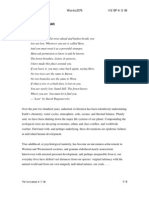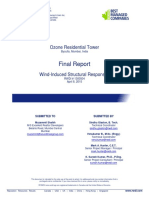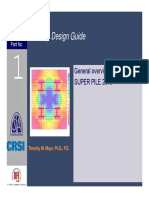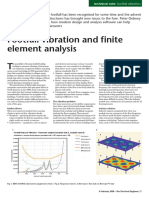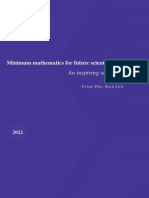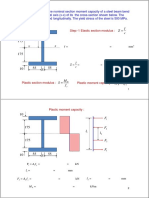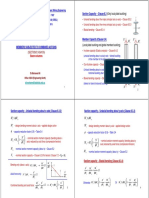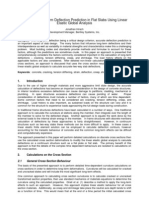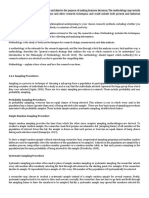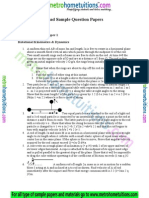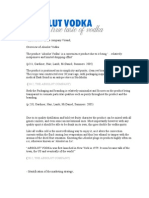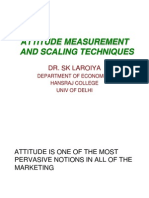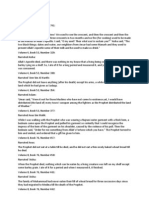Announcement SC Tall Buildings 2013
Announcement SC Tall Buildings 2013
Uploaded by
ptslabCopyright:
Available Formats
Announcement SC Tall Buildings 2013
Announcement SC Tall Buildings 2013
Uploaded by
ptslabOriginal Description:
Copyright
Available Formats
Share this document
Did you find this document useful?
Is this content inappropriate?
Copyright:
Available Formats
Announcement SC Tall Buildings 2013
Announcement SC Tall Buildings 2013
Uploaded by
ptslabCopyright:
Available Formats
Short Course on
SEISMIC ANALYSIS AND
DESIGN OF TALL BUILDINGS
Pavia, April 2-12, 2013
Istituto Universitario
di Studi Superiori di Pavia
Universit degli Studi
di Pavia
Pictures by courtesy of John A. Martin & Associates, Inc. in Los Angeles - www.johnmartin.com
BACKGROUND
Tall buildings are a special class of structures with their own peculiar characteristics and requirements.
Tall buildings are often occupied by a large number of people. Therefore, their damage, loss of
functionality, or collapse can have very severe and adverse consequences on the life and limb and on the
economy of the affected regions. Each tall building represents a significant investment and as such tall
building analysis and design is generally performed using more sophisticated techniques and
methodologies. Furthermore, typical building code provisions are usually developed without particular
attention to tall buildings, which represent a very small portion of the construction activity in most regions.
Therefore, understanding modern approaches to seismic analysis and design of tall buildings can be
very valuable to structural engineers and researchers who would like to have a better grasp on design
and performance of these icons of a modern megacity.
OBJECTIVES OF THE COURSE
The main objective of this course is to familiarize students with the state-of-the-art in seismic analysis and
design of tall buildings from the perspective of the United States academics and practitioners. At the end
of the course, students should be able to:
I
Understand common structural systems utilized in tall buildings and their design philosophy.
I
Perform preliminary design and analysis of various structural systems for tall buildings.
I
Conduct site-specific seismic hazard analysis and modeling, including necessary ground motion
selection and modification.
I
Develop analytical models for tall buildings using state-of-the-art structural analysis programs and
assess structural response under seismic excitation using such analytical tools.
I
Distinguish between prescriptive design methods and modern performance-based design methods for
tall buildings.
I
Understand the differences between component-based design and system-based design procedures
for tall buildings.
I
Conduct tall building performance evaluation both at component and system level based on state-of-
the-art methods and latest guidelines.
I
Effectively participate in structural design of tall buildings for specified performance objectives at
component and system levels.
PARTICIPATION
In addition to UME School students, a maximum of 20 external participants may be accepted to the
course, under the payment of a 500e fee. Special financial conditions are, however, in place for University
researchers or students, to whom a fee of not more than 300e is requested. Those wishing to attend the
course should contact the UME School Secretariat.
CONTACTS
UME School Secretariat
c/o EUCENTRE Foundation - Via Ferrata, 1 - 27100 Pavia, Italy
Phone (+39) 0382.5169867 - E-mail: secretariat@umeschool.it - Web-site: www.umeschool.it
ABOUT THE INSTRUCTORS
Farzad Naeim
is the Vice President and General Counsel at John A. Martin
& Associates, Inc. in Los Angeles, California. He received his
Ph.D. in Structural Engineering from University of Southern
California in 1982 and his J.D. with highest honors in 2002.
In 2007, he received the Fazlur Khan Medal for lifetime
achievements from Council on Tall Buildings and Urban
Habitat. He has served two terms (1995 and 2011) as the
President of the Los Angeles Tall Buildings Structural Design
Council. Dr. Naeim is a Past-President and an honorary
member of the Earthquake Engineering Research Institute
(EERI). Farzad has published four textbooks, more than 140
peer-reviewed papers, and has developed 45 different
software systems for earthquake engineering design and
education. Dr. Naeim has served as Technical Director for
many landmark structures in California and across the United
States.
Farzin Zareian
is an Associate Professor of Engineering at the University of
California-Irvine and his research is focused in the area of
Performance Based Earthquake Engineering (PBEE). Within
this area, his research efforts focus on applied structural
modeling (buildings and bridges) for enhancement of PBEE,
appropriate characterization of structural damping, and the
development of tools for implementation of PBEE by
engineering practice. Straddling the boundary of academia
and industry, his research requires a fundamental
understanding of the physical response of structures, as well
as practical design issues. Dr. Zareian received his Ph.D. in
Structural Engineering from Stanford University in 2006. He
has authored 8 book chapters and more than 50 peer
reviewed papers.
COURSE SCHEDULE April 2-12, 2013
Tuesday 2
09:00-12:00 and 14:00-17:00
Morning Session: Introduction to the Short Course (Naeim)
I
Scope of the Course.
I
Introducing Tools and Examples.
I
Structural Systems and Concepts for Tall Buildings.
I
Preliminary Design and Approximate Analysis Techniques.
I
Application Examples.
Afternoon Session: Structural Dynamics for Tall Buildings (Naeim)
I
Response to Impulsive Loads.
I
Modal Analysis and Direct Integration Methods.
I
Response Spectrum Analysis.
I
Design Spectra and Seismic Response Estimation.
I
Nonlinear Response History Analysis:
P-Delta Effects;
Component Nonlinearities.
I
Spatial and Temporal Variation of Drift and Acceleration in Tall Buildings
During Earthquakes.
I
Examples:
Application of CSMIP-3DV Software;
Miranda et. al. Approximate Formulas.
Wednesday 3
09:00-12:00 and 14:00-17:00
Morning Session: Seismic Hazard Analysis Fundamentals (Zareian)
I
Deterministic Seismic Hazard Analysis.
I
Probabilistic Seismic Hazard Analysis (PSHA) and Seismic Hazard:
Application Examples using OpenSHA and Ez-Frisk.
I
Uniform Hazard Spectrum (UHS) and Conditional Mean Spectrum (CMS), and
Code Target Spectrum.
I
Earthquake Ground Motion Selection and Modification.
I
Application Examples.
Afternoon Session: Performance-Based Seismic Assessment of Tall Buildings I (Naeim)
I
Componentbased Seismic Assessment:
ASCE-41;
LATBSDC;
PEER-TBI;
Application Examples.
Thursday 4
09:00-12:00 and 14:00-17:00
All Day: Overview of Seismic Design Principles (Naeim)
I
Design of Structural Steel Systems:
Steel Moment Resisting Frames;
Steel Braced Frames (Concentric, Eccentric and Buckling Restrained Braces);
Steel Plate Shear Walls.
I
Design of Reinforced Concrete Systems:
R/C Frames;
R/C Shear Walls.
I
Design of Foundation Systems.
I
Application Examples.
Friday 5
09:00-12:00 and 14:00-17:00
Morning Session: Structural Modeling of Tall Buildings I (Zareian)
I
Structural Modeling using SAP2000, and ETABS:
SAP2000, and ETABS Framework;
Component Modeling;
Analysis Options and Examples.
Afternoon Session: Structural Modeling of Tall Buildings II (Zareian)
I
Structural Modeling using PERFORM-3D:
PERFORM-3D Framework;
Component Modeling;
Analysis Options and Examples.
Monday 8
09:00-12:00 and 14:00-17:00
All Day: Structural Modeling of Tall Buildings III (Zareian)
I
Structural Modeling using Opensees:
Opensees Framework;
Component Modeling;
Analysis Options and Examples.
Tuesday 9
09:00-12:00 and 14:00-17:00
All Day: Performance-Based Seismic Assessment of Tall Buildings II (Zareian)
I
System-based Seismic Assessment:
PEER Methodology;
FEMA P-58 (ATC-58);
PACT Software;
Application Examples.
Wednesday 10
09:00-12:00 and 14:00-17:00
Morning Session: Setting Up Class Projects (Naeim)
I
Define and assign building projects to be used for analysis, assessment and
design to students or student groups.
I
Students will work on their projects during the course workshop days under
supervision and assistance of the instructors.
Afternoon Session: Class Project Workshop I (Naeim and Zareian)
I
Hazard Analysis, and Ground Motion Selection and Scaling.
Thursday 11
09:00-12:00 and 14:00-17:00
Morning Session: Class Project Workshop II (Naeim and Zareian)
I
Preliminary Design.
Afternoon Session: Class Project Workshop III (Naeim and Zareian)
I
Structural Modeling and seismic response analysis.
Friday 12
09:00-12:00 and 14:00-17:00
Morning Session: Class Project Workshop IV (Naeim and Zareian)
I
Damage Assessment and Loss Estimation.
Afternoon Session: Student Presentations and Conclusion (Naeim and Zareian)
I
Students present and discuss their projects and findings.
The European Commission has approved and financed within the Erasmus Mundus II the Masters on Earthquake
Engineering and Engineering Seismology (MEEES), coordinated by the UME School as part of the ROSE
programme and featuring also the participation of the University of Grenoble Joseph Fourier (France), the
University of Patras (Greece) and the Middle East Technical University (Turkey), which aims to enhance quality in
European higher education and to promote intercultural understanding through co-operation with third countries,
a relatively large number of scholarships are available for both non-European as well as European students.
Interested applicants are invited to visit the MEEES website (www.meees.org) for detailed information and
instructions on financial conditions and application procedures.
You might also like
- Nature and The Human Soul OverviewDocument8 pagesNature and The Human Soul OverviewJu Lee TayNo ratings yet
- CCWP-6 CCWPDocument64 pagesCCWP-6 CCWPKki YuNo ratings yet
- RWDI Ozone Residential Tower Final Structural Wind Load Report 1300504Document45 pagesRWDI Ozone Residential Tower Final Structural Wind Load Report 1300504nilang100% (1)
- Ram Concept RC Slab Tutorial 150227Document9 pagesRam Concept RC Slab Tutorial 150227ptslabNo ratings yet
- Sample Ipo SopDocument3 pagesSample Ipo SopJohnPauloCarmeloTuballas100% (1)
- Workshop Facilitation GuideDocument3 pagesWorkshop Facilitation Guideapi-325273054No ratings yet
- Effect of Podium Interferences On The Shear Force Distribution in RC Wall Supporting BuildingsDocument19 pagesEffect of Podium Interferences On The Shear Force Distribution in RC Wall Supporting Buildingsf430_boyNo ratings yet
- Tall Building MKA Jan 2011Document115 pagesTall Building MKA Jan 2011Mohd Alif100% (1)
- TallBuilding BrochureDocument6 pagesTallBuilding BrochureSonny AndalisNo ratings yet
- 2017 Latbsdc Criteria Final 06-08-17Document52 pages2017 Latbsdc Criteria Final 06-08-17Rannie IsonNo ratings yet
- 14WCEE Keynote PresentationDocument70 pages14WCEE Keynote Presentationmarianellachs100% (2)
- Shilpa PPT FinalDocument51 pagesShilpa PPT FinalDrakeNo ratings yet
- NBT - Wind Load Effects On SkyscraperDocument66 pagesNBT - Wind Load Effects On SkyscraperSYED SOHAILNo ratings yet
- Seismic Analysis of Multi-Storied Building With Shear Walls Using ETABS-2013Document11 pagesSeismic Analysis of Multi-Storied Building With Shear Walls Using ETABS-20138790922772No ratings yet
- 02-Mays Final PDFDocument25 pages02-Mays Final PDFRraffrizal ChandsNo ratings yet
- LATBSDC PEER CSSC Tall Building Design Case Study 1-05-09Document27 pagesLATBSDC PEER CSSC Tall Building Design Case Study 1-05-09bansaldhruvNo ratings yet
- AITC Modeling For PBD in Perform 3DDocument31 pagesAITC Modeling For PBD in Perform 3DMai KawayapanikNo ratings yet
- Displacement Based Seismic Design Chapter 01 (Points)Document14 pagesDisplacement Based Seismic Design Chapter 01 (Points)MuhammadNomanKNo ratings yet
- Strength of High-Rise Shear Walls - Rectangular Cross SectionDocument28 pagesStrength of High-Rise Shear Walls - Rectangular Cross Sectionamirreza3853No ratings yet
- Tall BuildingDocument4 pagesTall BuildingBoni ManatigaNo ratings yet
- Why Midas GenDocument35 pagesWhy Midas Genkdb92uceNo ratings yet
- Shear Wall FollowDocument41 pagesShear Wall Followsarkar69No ratings yet
- Highlights From Chapter 12 of ASCE 7-16 Provisions For Linear Dynamic AnalysisDocument32 pagesHighlights From Chapter 12 of ASCE 7-16 Provisions For Linear Dynamic AnalysisstaticsccpNo ratings yet
- PEER Performance Objectives For Tall BuildingsDocument114 pagesPEER Performance Objectives For Tall BuildingsFelipe CantillanoNo ratings yet
- Pankow Report 1 - Purdue University - Dual Plate Composite Shear WallDocument350 pagesPankow Report 1 - Purdue University - Dual Plate Composite Shear Wallvodugu123No ratings yet
- Handout ASCE 7-05Document59 pagesHandout ASCE 7-05Aqua MarineNo ratings yet
- 14 0005Document562 pages14 0005aenima696No ratings yet
- CE 412 Lecture 0 Course IntroductionDocument16 pagesCE 412 Lecture 0 Course IntroductionCivil Wallah Ahmed Rabbi100% (1)
- MSE Wall For Proposed SubstationDocument54 pagesMSE Wall For Proposed SubstationKenneth Salvador100% (1)
- 2014 EERI Technical Seminar Series - Performance Based Design State of The Practice For Tall BuildingsDocument323 pages2014 EERI Technical Seminar Series - Performance Based Design State of The Practice For Tall Buildingsbetzy_honey154380100% (1)
- Lateral Load Resisting Systems in High-Rise Reinforced Concrete BuildingsDocument9 pagesLateral Load Resisting Systems in High-Rise Reinforced Concrete BuildingsHussain AliNo ratings yet
- Wallace - PEER - Coupling Beams - Wallace - Oct 13 2009 FinalDocument41 pagesWallace - PEER - Coupling Beams - Wallace - Oct 13 2009 FinalStef22100% (1)
- Analysis of Wind Earthquake Load For Different Shapes of High Rise BuildingDocument8 pagesAnalysis of Wind Earthquake Load For Different Shapes of High Rise BuildingIAEME PublicationNo ratings yet
- Structural DesignDocument108 pagesStructural DesignPrasanna PandianNo ratings yet
- Tall Building Seismic Design and Analysis Issues - ATC-72Document97 pagesTall Building Seismic Design and Analysis Issues - ATC-72nikhilarora1988100% (4)
- Footfall The Structural EngineerDocument4 pagesFootfall The Structural EngineerSamuel ShimNo ratings yet
- CompositeMegaColumns Full ReportDocument275 pagesCompositeMegaColumns Full ReportRonakShah100% (1)
- Design and Analysis of Tall and Complex Structures - Feng FUDocument320 pagesDesign and Analysis of Tall and Complex Structures - Feng FUjoe zephNo ratings yet
- Precast Concrete: Instructional Slides Developed by Ned Cleland. P.E., PHDDocument175 pagesPrecast Concrete: Instructional Slides Developed by Ned Cleland. P.E., PHDMohamed SaaDNo ratings yet
- Wind Drift Design of Steel Framed Buildings An Analytical Study and A Survey of The PracticeDocument209 pagesWind Drift Design of Steel Framed Buildings An Analytical Study and A Survey of The PracticeShekh Muhsen Uddin AhmedNo ratings yet
- Pushover Analysis: Midas Gen - One Stop Solution For Building and General StructuresDocument29 pagesPushover Analysis: Midas Gen - One Stop Solution For Building and General StructuresSaiful Hoque SohelNo ratings yet
- Two-Way Flat Slabs: Direct Design MethodDocument26 pagesTwo-Way Flat Slabs: Direct Design Methodshara000No ratings yet
- Performance-Based Assessment and DesignDocument330 pagesPerformance-Based Assessment and DesignAbi IlamvazhuthiNo ratings yet
- Analysis of Steel Plate Shear Wall System Using Finite Element Analysis A ReviewDocument5 pagesAnalysis of Steel Plate Shear Wall System Using Finite Element Analysis A ReviewIJRASETPublications100% (1)
- Column Shortening in Tall Buildings LibreDocument38 pagesColumn Shortening in Tall Buildings LibreNuno FerreiraNo ratings yet
- Review of Conventional Seismic Design Intro To Performance-Based DesignDocument43 pagesReview of Conventional Seismic Design Intro To Performance-Based DesignmamandaweNo ratings yet
- Behavior of Gravity Load Designed Reinforced Concrete Buildings Subjected To EarthquakesDocument13 pagesBehavior of Gravity Load Designed Reinforced Concrete Buildings Subjected To EarthquakesMarimuthu KaliyamoorthyNo ratings yet
- Computer Aided Analysis and Design of Building StructuresDocument147 pagesComputer Aided Analysis and Design of Building StructuresMARUTHISH KUNCHAMNo ratings yet
- Nist TN 1863-2Document267 pagesNist TN 1863-2Ardian E PratamaNo ratings yet
- Global Analysis of Tall Buildings With Tubed Mega Frame StructuresDocument154 pagesGlobal Analysis of Tall Buildings With Tubed Mega Frame Structuresdxzaber100% (2)
- Presentation On Seismic Retrofitting of Reinforced Concrete BuildingsDocument37 pagesPresentation On Seismic Retrofitting of Reinforced Concrete Buildingsvineela saiNo ratings yet
- Seismic Design of Precast Prestressed Concrete Structures - PampaninDocument14 pagesSeismic Design of Precast Prestressed Concrete Structures - PampaninLuis Pablo Ramirez ZavalaNo ratings yet
- WebPEER 2015 12 KolozvariDocument143 pagesWebPEER 2015 12 KolozvariRory Cristian Cordero RojoNo ratings yet
- P-752 Unit8 PDFDocument175 pagesP-752 Unit8 PDFFeras TemimiNo ratings yet
- SESOC - Tips For The Better Design of Low RiseDocument399 pagesSESOC - Tips For The Better Design of Low RiseKenneth ZhangNo ratings yet
- Seismic Design Guidelines For Tall BuildingsDocument20 pagesSeismic Design Guidelines For Tall BuildingsIlanildo DiasNo ratings yet
- Concepts of Seismic-Resistant Design Steps in The Seismic Design of A BuildingDocument11 pagesConcepts of Seismic-Resistant Design Steps in The Seismic Design of A BuildingmttaibNo ratings yet
- CompositeMegaColumns Full Report PDFDocument275 pagesCompositeMegaColumns Full Report PDFWasin Waiyasusri100% (1)
- Plastic Design Multistory FramesDocument290 pagesPlastic Design Multistory Framesclam2014No ratings yet
- Design of Piles Under Cyclic Loading: SOLCYP RecommendationsFrom EverandDesign of Piles Under Cyclic Loading: SOLCYP RecommendationsAlain PuechNo ratings yet
- Structural Engineering DocumentsFrom EverandStructural Engineering DocumentsJorge de BritoNo ratings yet
- Advanced Opensees Algorithms, Volume 1: Probability Analysis Of High Pier Cable-Stayed Bridge Under Multiple-Support Excitations, And LiquefactionFrom EverandAdvanced Opensees Algorithms, Volume 1: Probability Analysis Of High Pier Cable-Stayed Bridge Under Multiple-Support Excitations, And LiquefactionNo ratings yet
- MathsDocument992 pagesMathsptslab100% (1)
- BeamName TB1Document12 pagesBeamName TB1ptslabNo ratings yet
- Step:-1 Elastic Section Modulus:: F A F LDocument3 pagesStep:-1 Elastic Section Modulus:: F A F Lptslab100% (1)
- DX DiagDocument36 pagesDX DiagptslabNo ratings yet
- N M N M: (Section 8: As4100)Document6 pagesN M N M: (Section 8: As4100)ptslabNo ratings yet
- P DrivDocument441 pagesP DrivptslabNo ratings yet
- Long Term DeflectionDocument11 pagesLong Term DeflectionUmesh PatilNo ratings yet
- 1 Excavation Methods and Support SystemDocument55 pages1 Excavation Methods and Support Systemptslab100% (2)
- RCC43 Wide Beams (A & D)Document30 pagesRCC43 Wide Beams (A & D)ptslabNo ratings yet
- DLPDocument38 pagesDLPSofia SJ Sta AnaNo ratings yet
- Principle of Business CH7Document63 pagesPrinciple of Business CH7rtNo ratings yet
- MethodologyDocument6 pagesMethodologyYuri PamaranNo ratings yet
- Positive PsychologyDocument17 pagesPositive PsychologyZarkoon FatimaNo ratings yet
- Theory of Mechanics and Mechanisms 4th EditionDocument9 pagesTheory of Mechanics and Mechanisms 4th EditionTimothy's SpaceshipNo ratings yet
- Giant Steps TutorialDocument8 pagesGiant Steps Tutorialinthekenzo100% (1)
- Vikings 2014Document181 pagesVikings 2014Thiago Manga Godoy100% (1)
- The Challenge From The Past Hal GalperDocument5 pagesThe Challenge From The Past Hal GalperTibsoNo ratings yet
- Ethical National SocialismDocument120 pagesEthical National SocialismRagnar100% (1)
- National Human Rights Institutions: 1. Ipra 2Document6 pagesNational Human Rights Institutions: 1. Ipra 2Princess Janine SyNo ratings yet
- IIT-JEE Download Sample Question PapersDocument3 pagesIIT-JEE Download Sample Question PapersSayan Kumar KhanNo ratings yet
- Tim and Eric and Zach For Absolut Vodka Viral 2008 FinalDocument11 pagesTim and Eric and Zach For Absolut Vodka Viral 2008 FinalMitchell Todd100% (1)
- Space and Subjectivity Latin American PDFDocument233 pagesSpace and Subjectivity Latin American PDFcodillosNo ratings yet
- Calder-Dawe Gavey 2016 Everyday SexismDocument9 pagesCalder-Dawe Gavey 2016 Everyday SexismkharaldsdottirNo ratings yet
- Inventory of Barriers To Creative Thought and Innovative ActionDocument4 pagesInventory of Barriers To Creative Thought and Innovative ActionDeRudy100% (1)
- The FIM Instrument Background Structure and UsefulnessDocument31 pagesThe FIM Instrument Background Structure and UsefulnessAni Fran SolarNo ratings yet
- The Mudd Journal of Ethics: Spring 2017Document48 pagesThe Mudd Journal of Ethics: Spring 2017Georgeta TufisNo ratings yet
- Localizing Images: Cultural Aspects and Visual MetaphorsDocument10 pagesLocalizing Images: Cultural Aspects and Visual MetaphorsSamartha VashishthaNo ratings yet
- Lesson Plan - Aerial Maps - Social Studies 2Document5 pagesLesson Plan - Aerial Maps - Social Studies 2api-367008553No ratings yet
- Paf-Data ScienceDocument44 pagesPaf-Data ScienceArijit BhadraNo ratings yet
- Verilog - ManoDocument43 pagesVerilog - ManoMohammod Ahad ArianNo ratings yet
- 1286376Document52 pages1286376servetNo ratings yet
- MR Attitude MeasurementDocument245 pagesMR Attitude Measurement9580890782No ratings yet
- Zuhd of The ProphetDocument4 pagesZuhd of The ProphetalialmardaNo ratings yet
- Module 1 - Doing PhilosophyDocument52 pagesModule 1 - Doing PhilosophyJoyce AlcantaraNo ratings yet
- Service Quality Management LectureDocument36 pagesService Quality Management LectureAfework AtnafsegedNo ratings yet
